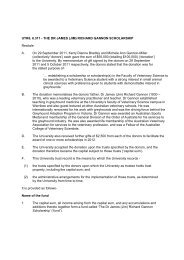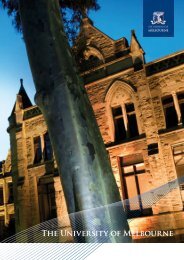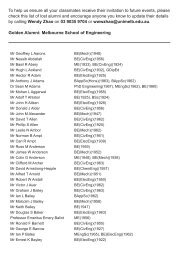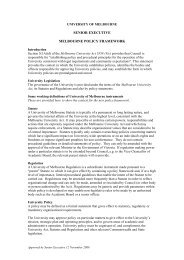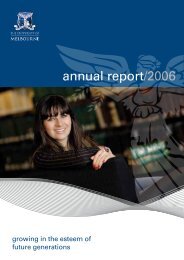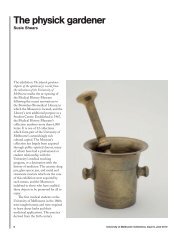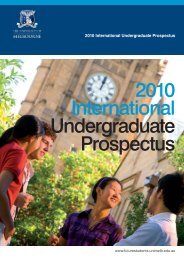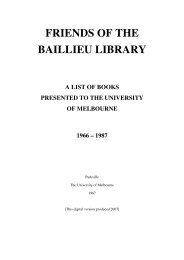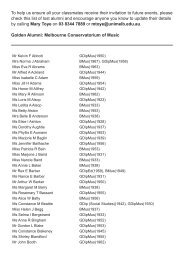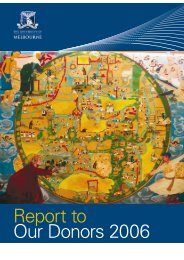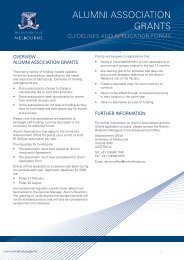Review of Australian Higher Education The Bradley Review
Review of Australian Higher Education The Bradley Review
Review of Australian Higher Education The Bradley Review
You also want an ePaper? Increase the reach of your titles
YUMPU automatically turns print PDFs into web optimized ePapers that Google loves.
Not all domestic students would be eligible for<br />
subsidies. <strong>The</strong> seven-year learning entitlement<br />
introduced in 2005 will from 2012 remove<br />
‘perpetual students’ from the subsidy system.<br />
Also, the price capping provisions associated with<br />
Commonwealth-supported places (see section 4.3)<br />
will leave some high-cost courses as entirely<br />
full fee, with no Commonwealth-supported<br />
places available.<br />
Greater system efficiency is also possible.<br />
Micro-managed incentive programs such as the<br />
Learning and Teaching Performance Fund could<br />
be abolished as unnecessary where the market,<br />
informed <strong>of</strong> performance (see the proposal at<br />
section 8.2), already provides incentives for<br />
universities to focus on student satisfaction and<br />
positive labour market outcomes. Better matching<br />
<strong>of</strong> supply with initial demand could reduce the<br />
number <strong>of</strong> people switching courses. Currently,<br />
more than 20% <strong>of</strong> commencing bachelor-degree<br />
students are admitted to university on the basis <strong>of</strong><br />
prior higher education study. Incorrect initial course<br />
choices could be reduced through more informed<br />
students making better choices and institutions<br />
being more responsive to those choices (more<br />
detail in section 8.2). Differential funding rates<br />
depending on institutional functions could also<br />
reduce costs (more detail in section 4). Growth<br />
in diploma enrolments, and in non-university<br />
providers which would not receive subsidies for<br />
research or knowledge transfer, would be cheaper<br />
for taxpayers than expanding through public<br />
university providers.<br />
It is difficult to cost an open system precisely.<br />
We have not attempted to calculate how much<br />
incorporating diplomas would cost, as this would<br />
involve negotiations with the states. If all 2008<br />
unsuccessful applicants for undergraduate places<br />
had received and accepted an <strong>of</strong>fer, in the same<br />
pattern <strong>of</strong> disciplines as actual acceptances, this<br />
would have cost approximately $100 million.<br />
For the reason noted above, this is an upper<br />
estimate. It would cost approximately $125 million<br />
to convert full-fee students at private higher<br />
education providers to Commonwealth-supported<br />
status. If all full-fee postgraduate places at public<br />
universities became Commonwealth-supported,<br />
it would cost approximately $200 million. It is not<br />
possible to estimate how much these conversions<br />
would be reduced because <strong>of</strong> students reaching<br />
the limit <strong>of</strong> their seven-year learning entitlement<br />
or institutions only <strong>of</strong>fering full-fee places. <strong>The</strong><br />
government already has around $105 million<br />
in the forward estimates to convert existing<br />
full-fee undergraduates at public universities to<br />
Commonwealth-supported places. <strong>The</strong>re would<br />
also be an <strong>of</strong>fsetting cost saving in the Learning<br />
and Teaching Performance Fund ($90 million<br />
for 2008–09). 3<br />
Recommendations:<br />
Lift quantity constraints on student<br />
numbers, and allow seven-year learning<br />
entitlement to be used from diploma to<br />
postgraduate coursework level.<br />
Use compacts to sustain rural campuses<br />
and low-demand disciplines.<br />
3 Due to data limitations, all calculations involve assumptions<br />
and should be taken as indicative only. <strong>The</strong> funding rates,<br />
budget numbers, applications numbers, and existing<br />
Commonwealth-supported places are all 2008. Other student<br />
numbers are from 2007 or projections for 2007.<br />
University <strong>of</strong> Melbourne <strong>Bradley</strong> <strong>Review</strong> Submission 11






